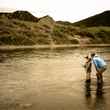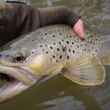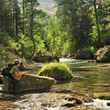It looked like an innocent jug of water — clear liquid in a corked nondescript glass bottle. But then I wondered why anyone would cork a bottle of water and set it on the mantle. So I asked Dad about it.
Dad said it was “shine.”
He chuckled a bit as he looped a finger through the handle and brought it down to my 15-year-old nose. With a slight twist, he pulled the cork. The jug responded with a soft and hollow “thumpf.” Set free from their confines, ethanol vapors swirled and danced through my nasal passages. Raised on the Grand Ol’ Opry, Hee Haw, and with a guitar-strumming old-country crooning father, it made me think of that line from Grandpa Jones’ song “Mountain Dew” about how what his Uncle Bill was brewing made “the buzzards in the sky get so drunk that they cain’t fly.”
The smell had a bite similar to the rubbing alcohol Mom used to get the ticks to back out on their own when one had imbedded into my summer-tanned hide. But there was something else in there, too, a sweetness I couldn’t quite describe.
I wanted a taste.
Dad said no, and it’s a good thing Mom wasn’t there or she would have gone ballistic just hearing me ask. This was the only bottle of alcohol in our home … that I was aware of, anyway. I think I saw Mom drink one glass of red wine one time. Dad had had a beer or two with me on a few occasions. I don’t recall ever seeing either of my parents even slightly intoxicated.
The level of shine in that jug never changed through the years. I’m not sure about why Dad wanted to display it on the mantle. Maybe it was for the same reasons I do now, which is mostly as a conversation piece. That old bottle has alternated between sitting on my own fireplace mantle or bookshelf for the 24 years since dad passed. I’ve never so much as dipped a finger in it during that time. In fact, years ago I dripped wax over the old cork to keep evaporation to a minimum. The reasons I had not indulged are complex, seeded in conflicting thoughts about all that the bottle represents.
Alcohol wasn’t a taboo subject in our home; it was a heavy subject, much like guns.
I’d overheard a few “grownups-are-talking” conversations at family gatherings. A stiff drink might have been a part of who we were in our cultural past, but it could potentially wreck a life. And when Mom wanted to drive that point, she didn’t need to do more than throw out a healthy dose of Assembly of God doctrine along with a few examples of relatives (most were distant) or family acquaintances who had drowned their job or their marriage or their liver or sometimes all three. They called it “fire water” because it burned your throat before warming your belly. But if you weren’t careful, it could burn down your entire existence.
Mom’s Scots-Irish blood ran back to a rogue king of Scotland who went by the nickname of “Black Knight” and married into the throne, and even further back to a general who fought alongside William Wallace. The fame and fortune of our ancestors had dwindled quite a bit before they moved to Ireland and then on to the New World. But that Scots-Irish heritage alone almost guaranteed that our family had a relationship with whiskey. Whiskey, or “whisky” in the Scottish spelling, is a Celtic endeavor. Even the word “whisky” is a corruption of the Gaelic “uisce beatha,” meaning “water of life.”
Dad rarely talked about alcohol at all, but that jug of corn whiskey sitting on a cherry wood mantle above our cast-iron wood stove came from Dad’s side of the family. His lineage was tougher to decipher. There’s a good probability that the Sains were of Scots-Irish descent, but regardless of the bloodlines, there is no doubt that they were entrenched in Scots-Irish culture. Owning a jug of moonshine was just one of the more obvious signs.
I reckon right here would be as good a place as any to clear up just what “moonshine” — AKA white lightnin’ corn squeezins, wild cat, mountain mule and several other interesting nicknames — really is along with a brief and vague history of how this particular bottle came to my childhood home.
“Moonshine” is nothing more than untaxed — therefore illegal — un-aged corn whiskey. Bourbons and Tennessee whiskeys are corn-based whiskeys, too, but those spirits will spend years in a charred white oak barrel before being bottled, and then they’re sold through retailers who collect a sales tax from the consumer. Moonshine goes straight from the still to the jug or jar, and it’s never taxed. It’s never sold legally. If you’re drinking un-aged corn whiskey bought from a licensed retailer with a sales tax paid, you’re just drinking plain old un-aged corn whiskey. You are not drinking moonshine.
After the 21st Amendment became law, which did away with the 18th Amendment (prohibition), un-aged corn whiskey was still illegal for reasons that are still unclear. After researching for days, I follow the one thread discovered. It’s an acutely niche blog site dryly titled “Alcohol Law Advisor.” I call one of the blog’s editors, Washington D.C. attorney Art DeCelle, who specializes in advising alcoholic beverage companies on federal regulations. Art isn’t sure about the reasons, either, but offers an educated opinion. “At the end of prohibition, the federal government was probably seeking to keep this specific type of alcohol tamped down because of its long association with illicit activity,” Art says. “And the industry probably lobbied for regulations regarding aging and such to keep competition off of the market as well. But I’m really not sure about all the reasons.” I could not uncover anything more substantial in my own digging, and those theories fit well with the historical narrative of white whiskey.
The reasons behind the legalization of un-aged corn whiskey are crystal clear. It was a response to the 2008 recession. And — in perhaps the ultimate twist of irony — the main impetus behind it was to keep tax revenue rolling into government coffers during tough times. Tennessee was the first state on board in 2010, but was followed quickly by other Southern states.
There’s a lot of legends out there about the etymology of the word “moonshine” with the most popular (and likely most accurate) theory saying that “moonshiner” was first used as a reference to Appalachian distillers operating by the light of the moon so the revenuers couldn’t see the smoke from their fires. There’s also an Old World folk story of “moonshiner” as a derivative form of “moonraker” with roots also buried in illegal alcohol culture as a term used for English brandy smugglers who hid their booty in a pond, retrieving it with a rake. If busted by the taxman while retrieving it, they feigned delusion and claimed they were trying to rake up cheese in the moon’s reflection. This latter theory sounds like the raking up of so much bullshit to me, but who knows and it doesn’t matter.
Whiskey started in Scotland and Ireland when the art of distilling made its way west from mainland Europe courtesy of monks sometime between 1100-1300 AD, and it’s always had a bit of the outlaw mystique attached to it. Scottish and Irish people in general have never cottoned much to government authority (that authority was usually in the form of an English boot trying to step on their necks) and they sure as hell didn’t want to fund an oppressive government in the form of taxes paid on their liquor. According to Heidi Donelon, an Irish whisky historian and founder of the Ireland Whiskey Trail, when England began taxing Scottish distilleries in the 17th century, it didn’t take long for illegal stills to pop up all over the rugged highlands. And when the number of licensed distilleries in Ireland dwindled to just 20 in 1799, there were an estimated 800 illegal stills operating in one county alone.
All of this — the love of whiskey, the hatred for taxation, and a cultivated cultural disposition to thumb their nose at authority — came along with many of the Scottish, Irish, and Scots-Irish to the New World. The Scots-Irish, in particular, followed the spine of Appalachia down from Northeast ports and settled in areas across the South — often with an affinity for the highlands — and brought their whiskey-loving, tax-evading ways along with them. The final leg of the journey for Dad’s folks was crossing the Mississippi River from Tennessee (there’s actually some remnants of a community called “Sainville” in Tennessee) and into Arkansas where they went straight for the hills again. Mom’s family went a little north into the Missouri Ozarks.
In Arkansas, the Sains weren’t known for making moonshine. But my paternal grandmother’s family, the Heffley’s, had cookers in the bunch. My Grandpa Sain did, however, sell a few jugs of moonshine out of his store (I think my “heirloom” jug came from one of his old suppliers, but I don’t know). Or so the story goes. The funny thing about those stories is that I’ve heard them off and on through the years without even asking. But place a recorder and a notepad in my hand, and folks — even family — seal their lips up tighter than bark on a tree.
Take my second cousin Charlie Heffley for example. Charlie was first cousin and best friend to my dad when they were growing up. He’s been my go-to for stories that many of the gentler souls in our family haven’t shared with me. He’s even told me how Grandpa wouldn’t sell “wildcat” to him or Dad, so they would sometimes sneak a nip here and there from jugs Grandpa thought were hidden. I call Charlie for an interview.
“Hey, Charlie, this is Johnny Jr.”
“Well, hey, Johnny Jr.. How ya doin’”
“Fine, just fine. Hey, Charlie, I’d like to interview you for a story I’m working on.”
Why shore, come on over sometime. How ‘bout Friday?”
“Friday would be great. Now, Charlie,I need to tell you that this story is about moonshine and Grandpa doing a little bootlegging. Are you cool with that?”
Long silence.
“Well, Johnny Jr …”
We meet and we talk, but Charlie is a master at dodging questions and changing lanes. The only thing I get out of him is that Grandpa sold a little moonshine every now and then. I tell Charlie that wasn’t the story as I understood it. Charlie starts talking about how much my dad loved squirrel hunting.
Neither blood nor water is thicker than moonshine. It’s always been this way.
Even the folks today who make un-aged corn whiskey legally will talk only about certain aspects of the craft. Father and son distillers Gary and Jon Taylor have owned and operated White River Distillery in Gassville since 2012. Both are eager to discuss the nuts and bolts of distilling along with some history as long as it didn’t get too personal.
“Why a distillery? Is it because you’re a craftsman?” I ask
“Well, yeah,” Gary says. “With the change in the laws about six or seven years ago, everyone was getting this un-aged corn whiskey thing going, and we thought we could put out a good product at a fair price.”
Gary’s response to my first question leads me to ask a pointed follow up.
“Did you do this before it was legal?” I ask.
“Pardon me?” Gary replies.
“Did you make moonshine before it was legal?”
“No comment.”
This isn’t Gary’s first go-round with a nosy journalist.
“I had Ozark public television call me and ask questions for a story, and they asked if I knew any guys still cooking in the woods that they could come down and film,” Gary says. “For one of the few times in my life I was speechless. And then the only words that could come out my mouth were ‘are you fuckin’ kiddin’ me?’”
Yes, there are still people making moonshine in Arkansas and other states as well. But no one is going to tell you who or where if you have to ask.
A foundation of Scots-Irish culture is to never mess with a man’s means of making a living — legal or not. And lost in the modern romantic notions of moonshining, brought to us by the Duke boys and the Discovery Channel, is the hard fact that moonshining and bootlegging were about survival — period. They were not, by any stretch, glamorous occupations; there simply weren’t other options available for making money. “Look at the whiskey rebellion,” Gary says. “They wanted to tax the liquor to pay for the Revolutionary War. And this was these guys livelihood. Not everyone can have 100 head of cattle or 80 acres of tobacco.”
Backcountry folks were never wealthy folks, and this truth stretches across the years and across the Atlantic to Ulster, Ireland, and the Scottish borderlands. Making whiskey from your barley or corn created a product that was easier to store, easier to transport and easier to sell. It was often hill folks most profitable “cash crop.” But no one got rich off of moonshine. And “sampling” the product was often a favorite way to dull the harsh realities of poverty.
The parallels between today’s illegal substances and moonshine of years past, and the common denominator of poverty-stricken areas are stark.
Gary’s family roots were watered with illicit alcohol just like mine. “Rumor has it that my parents and my wife’s parents were making liquor and selling it during prohibition,” Gary says. “One was in the Black Hand, the forerunner of the Mafia. And one was Scots-Irish.”
Gary gives the same weight to organized crime and Scots-Irish ethnicity when it comes to illegal alcohol. The association is just that strong.
But with white whiskey out of the shadows now and commanding more than a cult following, Gary is concentrating on steering his business into manageable growth while clinging tightly to the old ways. “Those old cookers were pretty smart,” Gary says. “You’ve got to have a combination of physics, chemistry, engineering, and microbiology. And they didn’t have the equipment we have now. They didn’t have hydrometers to check the specific gravity of the mash. They tasted it. It was an art. And it was passed down through the generations. I’ve heard of yeast strains stretching back for a hundred years. How do you keep this going and keep getting away with it?”
For Gary and Jon, it all starts with clean water courtesy of a 500-foot limestone-rimmed well near the distillery. And then it’s ingredients brought together with some old-fashioned methods. “I think it’s an important part of the history of this country that somebody has to do things in the traditional way,” Gary says. “I think you need to do it the way we do it — by hand. Mix the stuff yourself. We’re even looking at coming up with our own local yeast strain.”
White River Distillery does use all-electric equipment to “cook” with. “It’s safer than an open flame,” Jon says. “You can regulate the heat better and it gives you a more uniform product.”
But true to the scofflaw spirit of white whiskey, Gary says they could relocate to the shaded hollows and make moonshine if need be. “Could we take these things out into the woods and do it?” Gary says. “You bet. But I don’t think prohibition is something we’ll have to worry about again.
Just before we say goodbye, I try to trip Gary with a loaded question. “Do you miss the outlaw mystique before 2012?” I ask. I don’t know if I’ve penetrated Gary’s circle of trust or if he just doesn’t care, but he answers with sincerity.
“Yeah, kind of,” Gary says. “It’s a distinctly American thing, like fudging on your taxes. How much can you get away with?”
Outside of an indulgent stretch during my early 20s and a beer now and then, I’ve never been a drinker. Despite the genetics, some predisposed personality quirks and a few rough times, Mom’s words and Dad’s example carried me through. But a few years ago, when I learned more about my heritage and in particular the Scots-Irish component, I began an intriguing cultural journey through various types of whiskey. I've not tried them all by a long shot (kind of a pun if you stretch really hard), mostly bourbons and Tennessee whiskeys. And I've been lucky to sample better than half a dozen types of Scotch.
The bourbons and Tennessee whiskeys taste like corn and white oak with hints of sugar maple in some of the sweeter creations. Of course, there is more complexity, nuanced differences, variations in water and grain along with distilling practices that make me appreciate one over another — some are delicious and some suck — but this is their essence in general. They taste a little like the backwoods, but tamed. They’re domesticated.
The Scotches I've tried so far are vastly different. They taste ancestral, somewhat austere, like early forms of something not yet determined but somehow more refined than what they gave rise to in the New World through distilled anagenesis. There are no generalities with Scotch. The flavors are all over the board — light, heavy, tender, brawling — I've not found a consistency at all. Again, it’s due to the variables and regional peculiarities. Lagavulin is my favorite. It’s primordial. It’s an ancient seashore with North Atlantic waves pounding on stones formed before time began, cold salt spray, peat, and a driftwood blaze. It tastes like the origin. And at $100 a bottle, it's something I'll be sipping slowly and only for the most celebratory of reasons. In another twist of irony, it’s a drink that most of my ancestors could never afford and represents the antithesis — wealth, refinement, sophistication — of moonshine.
I ponder all of this as morning sun pours through our living room windows and through Dad’s bottle of shine. The liquid is clear as spring water. I turn the bottle and the moonshine plays with the light, bending, compressing, refracting.
I always imagined that one day I’d take a pull from the jug. Maybe it would be on Dad’s birthday or maybe Grandpa’s birthday. Maybe some other momentous occasion. Or maybe, if I were to be blessed with the luxury of this option, I might take a few snorts on my death bed. That’d be a helluva way to go out.
Today is just a Monday in May. I’m in apparent good health with a full day of writing, editing and emails and maybe some fishing this afternoon. But it sure seems like a good day for a swig or two.
Peeling layers of wax with my fingers, I get to the cork only to discover that it’s become the consistency of cornbread. So I open a blade on my Old Timer pocketknife and gently poke it into the cork, hoping to pry it loose with minimal crumbling. But the cork is too far gone, and I am entirely too impatient. Soon the bottle opening is clear with about half the cork sitting on the kitchen counter and the other half floating in what’s rumored to be some of Newton County’s finest. It’s the whiskey’s first breath of air in a quarter century.
I grab a Mason jar from the cabinet (what else could I use) and fashion a crude sieve from an old T-shirt. I pour and that wonderful sweetness fills my nostrils. I remember that smell, but now other notes that I’ve come to recognize with age, knowledge, and a wiser palate join the ethanol. The Mason jar is nearly full as the jug empties.
Damn … it smells good.
I’m leery, though. If the moonshine is straight from some unregulated Ozarkian still, there could be dangers lurking. Moonshine cookers were resourceful by necessity like all poor folks. If you’ve ever wondered why many rural homes have stacks of junk in the backyard or sheds overflowing with the material detritus of stuff kept long past what you’d consider its useful life, it’s because those people have been repurposing before repurposing was cool. You didn’t throw anything away because you never knew when you’d need some doodad that you couldn’t find at the store and couldn’t afford if you did. So you fashion what you need out of something else. This shine could have dripped out of an old automobile radiator complete with residual — and extremely toxic — antifreeze. It could be laced with lead. Who knows what all was used to make this whiskey and what’s in it?
I don’t. But I do know a rough backwoods method of determination. You simply take a spoonful of shine and light it. A blue flame means it’s good to go and no more dangerous to your innards than any other distilled alcohol. If the flame burns red or yellow, throw it out. I fish the Bic lighter out of one of our junk drawers (keeping a few junk drawers is, after all, part of my heritage), pour a smidgen of Dad’s shine into a teaspoon and light it. A glowing ball of cobalt dances on the spoon.
I grin. And then I lift the jar to my lips and take a sip.
It tastes better than it smells.
I roll it around in my mouth letting every tastebud have a sample. I close my eyes and note the sweetness of golden summer corn and limestone-filtered spring water. I hear fiddles on the front porch accompanied by whip-poor-wills and the clink of Mason jars. I see people who faced true tyrannical governments, who endured long weeks on the Atlantic, perilous treks across the Appalachia Mountains, across the Mississippi River and finally into the Ozark hills. I see poor mountain folks whose pride could never be bought, who lived hand-to-mouth in ways I could never imagine. I see a man who opened a small store in one of the poorest counties of our state finding innovative ways to make a dollar when dollars were hard to come by. I see a teenage boy, who looks an awful lot like me, and his cousin alternating between stolen swigs and keeping a watchful eye for grownups.
The shine tastes like where I come from in every sense of the phrase.
I swallow and the smoothness is surprising. A little burn, just enough spice to give it a kick. Then a comforting warmth settles in my belly.































Comments
Gerry Quigley replied on Permalink
Thank you for making me home sick... God Bless
Pages